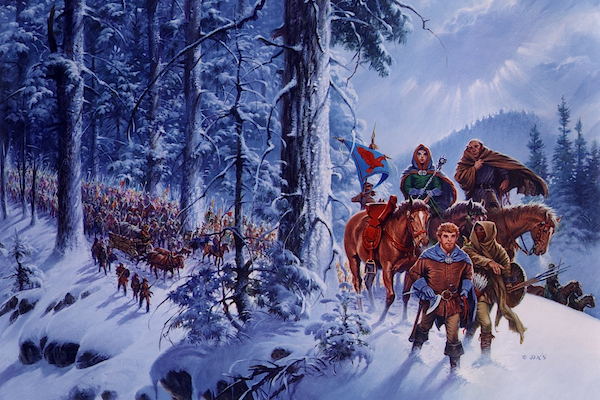Welcome back to Reading The Wheel of Time! This week we are covering Chapters 34-36 of Lord of Chaos, though we’ll be stopping a little short of the end of Chapter 36, just before Nynaeve and Elayne come to see Egwene—the chapter breaks up their conversation in a weird place, so I’m going to lump that entire exchange into next week’s analysis rather than doing part here and part later.
Chapter 34 is a light, breezy chapter before we get into some nitty gritty aspects of Aes Sedai politics and Egwene grappling with a very extreme and sudden change in her circumstances. Even having called this a long time ago, I’m fascinated to see how the Aes Sedai are handling this very unusual and custom-breaking move they are making, and how Egwene is going to defy all their expectations. Whatever else happens, I think the Wise Ones are going to be very proud.
Everything in Egwene’s Aiel tent is hers, but she can only take what fits into her saddlebags. Once packed, she sets about the business of channeling Spirit in the way she has theorized.
The air shimmered in the middle of the tent along her weave, cloaking the other side in mistiness. If she was right, she had just created a place where the interior of her tent was so similar to its reflection in Tel’aran’rhiod that there was no difference at all right there. One was the other. But there was only one way to be sure.
When Egwene steps through, she finds herself in Tel’aran’rhiod. It feels the same as when she travels there by Dreaming, and when she tries to manipulate her surroundings in the same way she would have on a normal trip into the dream, she manages to create a dream version of Bela, complete with saddle. Realizing how uncomfortable she would be riding in her current physical condition, she also manages to change herself, erasing her injuries.
Buy the Book


The Eye of the World: Book One of The Wheel of Time
She climbs into the saddle, forming the mental picture of Bela running like the wind. Even as she thinks it the mare takes off, each step seeming to carry them miles as the landscape blurs around them. Bela’s gait still feels like the plodding Egwene remembers and there’s little sensation of movement, and Egwene finds she greatly enjoys each leap.
A day or two to reach Salidar? That was what Sheriam had said. The Wise Ones were right. Everyone had believed for so long that Aes Sedai knew everything that Aes Sedai believed it, too. She was going to prove them wrong tonight, but it was not likely they would take any real notice of her proof. They knew.
As Egwene reaches Altara she starts having Bela take shorter jumps, occasionally trotting through villages to get her bearings, until suddenly she finds herself entering a large village that she decides must be the right place. She dismounts, bidding Bela a fond farewell and wishing she could bring the mare with her into the waking world. Then she weaves her curtain of Spirit and steps through.
She stops a woman in an apron and asks to be directed to Sheriam, and the woman, Nildra, grouses about being asked to do everything for everyone before leading Egwene to a house. Inside, all seven of the Aes Sedai Egwene saw in Salidar are seated in a semi-circle having some sort of meeting, including the mysterious Siuan. They all fuss over her, asking about ill-effects and offering Healing, which Egwene is quick to forestall. But when Siuan speaks, reminding them all that they must get Egwene ready to face the Hall, Egwene is shocked to recognize that she is actually Siuan Sanche. She struggles to accept the explanation they give her, that Siuan is Aes Sedai again, that Nynaeve has discovered how to Heal stilling.
Then, Sheriam tells Egwene solemnly that she has been summoned for a very special reason—she is to be the next Amyrlin Seat. Egwene’s first thought is that maybe this is some kind of joke, but no one seems to be very amused. She points out, as neutrally as she can, that she isn’t even Aes Sedai. Beonin, a Gray, explains.
“The Amyrlin Seat, she is Aes Sedai—the law is quite clear; several places it is stated, ‘the Amyrlin Seat as Aes Sedai’—but nowhere is it said that it is necessary to be Aes Sedai to become Amyrlin. […] The law that sets forth how the Amyrlin is to be chosen, it merely says ‘the woman who is summoned,’ or ‘she who stands before the Hall’ or the like. From beginning to end, the words ‘Aes Sedai’ are mentioned not once.”
Egwene realizes that this isn’t a joke after all, and notes a tiny smile on Siuan’s otherwise serious face. She protests weakly, thinking of all the experience and knowledge that the Amyrlin is supposed to have. She eventually manages to tell them that she wouldn’t know what to do, and that she won’t paint herself a fool in front of everybody. But she’s told that one cannot refuse a summons to become Amyrlin any more than one can refuse summons for a trial: “The words of the summons are even the same.”
Sheriam promises Egwene that they will be there to guide her, and then everything is a blur of activity as an Accepted’s dress is found for Egwene and she is schooled on what will happen, and everything she must do and say. When the Aes Sedai are satisfied, they escort her down the streets to another building where Anaiya reassures Egwene that it will go well and a gong sounds inside the building.
Escorted in by Sheriam, Myrelle and Morvrin, Egwene finds herself in a brightly lit room, lined with chairs in which the Sitters for the Ajahs sit, wearing their shawls and dresses in the color of the Ajahs. They begin the ritualized set of questions, and Egwene is shocked to find her voice is somehow steady.
Among the Grays below Romanda a dark, slender woman stood. As the youngest Sitter, Kwamesa spoke the ritual question that dated to the Breaking of the World. “Are there any present save women?”
One by one, the Aes Sedai begin bearing themselves to the waist and announcing “I am a woman.” Kwamesa walks around the room inspecting each woman in turn, then they dress again, except for Egwene who has to wait until later in the ceremony.
Next Romanda asks who stands for Egwene. Sheriam, Myrelle, and Morvrin pledge themselves for her. Again Egwene completes a ritualized request to serve as Amyrlin, after which nine of the eighteen sitters stand, signifying their acceptance. For the rest, Egwene has been warned that this might happen—staying seated is not an outright rejection, but a way of the Sitters showing that they did not intend to be lapdogs for the Amyrlin. Egwene, with the help of Sheriam and Myrelle, goes to each in turn, asking to serve. When asked, each Sitter presents her bare feet for Egwene to wash.
After she has washed all nineteen, Egwene returns to her place and again repeats the request to serve. This time all but Lelaine and Romanda stand. Lelaine also stands after a moment, but Romanda gives Egwene a long, hard stare. When she eventually stands, Egwene hears someone behind her gasp in relief.
After that Egwene is re-dressed and formally declared the Amyrlin, her great serpent ring moved from her left to her right hand and she sits on the seat prepared for her. Her three attendants form a line, followed by all the Sitters in ascending age order, each asking to be allowed to serve, and Egwene offers her ring for each to kiss as she gives them permission to do so. Then they depart, leaving only Sheriam, Myrelle, and Morvrin.
Egwene asks what would have happened if Romanda hadn’t stood, and learns that she probably could have gone back to being an ordinary Accepted, but also that women who are refused the Amyrlin Seat are usually exiled, since they could not help but be a source of disharmony in the Tower. Sheriam tells her seriously that those who stood for her definitely would have been exiled. They tell her that they need to fill her in on how matters stand in Salidar, and Egwene agrees.
Egwene wakes the next morning in the bedroom Anaiya has set up for her, surrounded by the best mismatched furniture and an incredible amount of lace and frills. The night before had consisted mostly of Sheriam and the others talking and Egwene’s questions being answered perfunctorily or not at all. She learned about the Salidar embassy to Caemlyn and that ambassadors have been sent to every ruler. She also learns about Gareth Bryne and his army.
When someone let slip that Logain had also been Healed, Egwene had been assured that dealing with that was no concern of hers, then urged to get some rest. But Romanda had shown up once Sheriam and the others left, followed by Lelaine, each offering counsel and insinuating that she could guide Egwene better than Sheriam and that the others might pull Egwene in too many directions at once. Egwene had nightmares about being a terrible Amyrlin or being ousted and laughed at for believing that she, an eighteen year old girl, could be Amyrlin, though she was sure that they were only ordinary dreams, not those with meaning outside of her own mind.
Chesa, the Amyrlin’s maid, notices Egwene’s injuries, but when Egwene claims to have had an accident she relaxes, assuming Egwene was thrown and going on about how untrustworthy horses are and how personally she’d never tell anyone about such an accident, given how people talk, though of course it’s different for the Amyrlin Seat. Egwene catches on at once to what the woman is trying to say.
Egwene smiled at her. “People are people, low or high,” she said gravely.
Chesa beamed for an instant before bringing out the blue dress. Anaiya might have chosen her, but she was the Amyrlin Seat’s maid, and her loyalty was to the Amyrlin Seat. And she was right about today’s importance, too.
Egwene eats quickly and dresses in blue silk, settling the Amyrlin’s stole over her shoulders, then descends downstairs where she finds the Sitters waiting for her. Again they line up according to age, this time with Romanda, the eldest, in the lead, and go outside. Egwene waits just inside the doorway until she hears Romanda announce her. Then she goes out, lifted up on a platform of Air by the Sitters, and looks down on the packed streets of Salidar. Everyone cheers, and she has to wait for them to settle before she can speak, even with the weave that carries one’s voice.
The speech she gives was written by Sheriam and the others, but Egwene has made some changes. After announcing that they will not falter in their quest for truth and justice, and that she, as their Amyrlin, will not falter in leading them, Egwene dispenses with the rest of the exhortations that were included in the speech and names Sheriam as her Keeper. As is traditional, Egwene decrees that all novices and Accepted are absolved of any penances and punishments. Then she makes her own decree, not at all traditional, declaring Theodrin, Faolain, Nynaeve, and Elayne are raised to the shawl and full Aes Sedai.
After returning to the script and declaring the rest of the day to be one of feasting and celebration, Egwene finishes her speech to the sound of cheering and is brought back down, perhaps a bit more quickly than necessary, by the aggrieved Sitters. Sheriam quickly hustles her away to “show the Amyrlin her study,” then explains that every Sitter has had a hand in writing her speech. Also, while Theodrin and Faolain will certainly be raised once they have the Oath Rod again, Nynaeve still can’t channel without being angry.
Romanda enters at that moment, followed by Lelaine, saying that she came to raise the same point, and Egwene gives them both an innocent look, pointing out that she felt she had to do it—having been raised Aes Sedai without taking the test or swearing on the Oath Rod, she won’t stand out so much when there are four others who have been similarly raised. She points out that Elaida might try to make something of it but most people don’t know enough about Aes Sedai for that to matter, and that what’s important is the confidence the people of Salidar have in her.
“I hope, Mother,” Romanda said in a tight voice, “that you will consult the Hall first the next time. Going against custom can have unexpected consequences.”
“Going against law can have unfortunate ones,” Lelaine said bluntly, tacking on a belated, “Mother.” That was nonsense, or close to it. The conditions for being raised Aes Sedai were set in law, true, but the Amyrlin could decree almost anything she wished.
Still, Egwene knows she shouldn’t fight with the Hall unless absolutely necessary, and earnestly promises to consult in the future before asking them to leave her to consult with the Keeper. Sheriam appears surprised at how well Egwene handled them, but reminds her that she should consult with her Keeper, who can advise her and keep her away from problems with the Hall.
Egwene assures her that she understands, and then asks to see Elayne and Nynaeve. Sheriam promises to get them, and mentions that Siuan will be coming later to teach her about the etiquette of being Amyrlin. Once she’s gone, Egwene studies her empty desk, considering how there is no work left here for her to do, and that Siuan is specifically coming to teach her etiquette.
Bela! A Bela sighting! A wild dream Bela!
It’s taken me more than a few moments of wracking my brain, but… isn’t Bela in Salidar? I know Siuan rode her out of the White Tower when they escaped, but I’m not sure I remember what happened to Bela after they were all caught in the barn and sentenced to work for Gareth Bryne. Did Logain have all the horses with him? I… think he did?
Okay, but if that’s right, then that means Egwene’s wish to bring Bela with her is going to be granted, but better! Because she doesn’t even realize that the real Bela is there in Salidar waiting for her. Boy, I hope I’m right about this. Somebody tweet at me, let me know where Bela is at this point in time.
I had a moment where I was worried Egwene might try to pull Dream Bela from Tel’aran’rhiod into the real world somehow. I don’t know why, maybe the Wise Ones’ warnings were still in my head or something, making me think Egwene would immediately turn into a power hungry monster because she entered Tel’aran’rhiod in the flesh. I felt like I was looking for some example of the thing they are afraid of, some lack of perspective or abuse of power. Which probably wouldn’t show after only one trip anyway, but the only people we’ve seen go to Tel’aran’rhiod in the flesh are the Forsaken, who are already power hungry, amoral monsters, and Rand, who has other, more pressing reasons to struggle with his sanity and perspective. So this is the first time we’ve seen someone more ordinary step into the World of Dreams in the flesh.
I’m curious about the differences in channeling when one is in the Dream in the flesh versus as a Dreamwalker. We know that people are stronger in their channeling in the flesh, I think because only Spirit can be channeled by someone who is asleep. Which makes sense, if only because the Dream provides other ways to interact with and change your surroundings. Amys turned into a monster, Nynaeve produced an a’dam with a thought, Egwene made a perfect facsimile of Bela right down to her personality. That’s more than one can do with channeling in the waking world. But I’d love to learn more details, and I’m curious about the metaphysics of the fact that, despite being a Dream where one’s consciousness, or spirit, travels without one’s body, a person can physically go to, and interact with, Tel’aran’rhiod. It’s similar to the other mirror world that Rand, Loial, and Hurin traveled to in The Great Hunt, but that place still seemed physical—“real,” for a lack of a better term—in a way that Tel’aran’rhiod did not to me. So I want to learn more about that.
I also really enjoyed the sequence of Egwene traveling, which had a very cinematic quality; I could picture it very clearly in my mind. As y’all know from this read, I love a good visual description of place. It’s one of the reasons I became obsessed with epic fantasy as a kid, and as usual, Jordan delivers here.
I’m less enamored with the ceremony to raise the Amyrlin. The idea that the participants exhibit their womanhood by baring their breasts (and having them inspected!) is just ridiculous. The narration says that this tradition dates back to the Breaking of the World, so I guess the point is to ritualistically mark the fact that there are no dangerous saidin wielders in the group? Like, was that a problem at some point? Were taint-crazed men trying to infiltrate the ceremonies?
The whole time I was reading that section, I couldn’t stop thinking about the current bathroom debates, and the ongoing suggestion from conservative pundits that predatory men will dress up as women in order to exploit trans-inclusive bathroom policies to assault women. This is obviously just a thin smokescreen for bigotry and oppression. But it’s also just ludicrous to suggest that would-be predators would bother with complicated ruses, while ignoring the actual realities of sexual assault.
Putting aside the fact that breasts do not a woman make, in this world that Jordan has written for us, women can sense the ability to channel in each other! You don’t need to look at someone’s body when you can tell she can wield saidar! So really, it’s hard to buy this flimsy reasoning from Jordan here, especially in a series of chapters where he’s also very focused on Egwene’s sore bottom, everyone’s neckline, and the fact that Siuan used to be middle-aged (i.e. old) and “leather faced” but that stilling made her young and soft and pink-cheeked pretty (just in time for her to fall in love with a man who looks older than her, I might add).
Coincidence? No. I’m sorry Jordan, I’m not going to allow you to get away with this one. In fact, I’d like to direct your attention to Sir Terry Pratchett, and this particular quote from Good Omens:
Most books on witchcraft will tell you that witches work naked. This is because most books on witchcraft are written by men.
Anyway.
I did really enjoy the way the ceremony focused on the idea that the Amyrlin is a servant, and that all Aes Sedai are servants of the people. The humbling act of washing the Sitters’ feet as part of her bid to serve is a nice touch—the Amyrlin may be head of the Aes Sedai, and “Mother” to them, but this is not the same as being a ruler. In a way, it’s not that different from being the Car’a’carn. Rand may be the chief of chiefs, but that is not the same thing as being a King, as he is constantly reminded by his followers. He is the first among equals, as the Amyrlin is “mother” of the Aes Sedai.
It all has a very Catholic feel as well, Jordan no doubt drawing from his own religious background as an Episcopalian. Just as Jesus washed the feet of his disciples before the Last Supper to show that he was not only a Lord and Savior but also a servant, so does the Amyrlin wash the feet of those who wish her to remember that they are not her blind servants—or lapdogs, as it is put to Egwene. And then once she is raised, they must ask to serve in turn, and kiss her ring, the way one would in the olden days for a high-ranking religious leader. Later, Egwene pardons the Accepted and Novices who are serving penance, another common occurrence in the Middle Ages after coronations and such. I wonder if it’s also common in Tar Valon to pardon and release prisoners—obviously they don’t really have those in Salidar right now.
I find it interesting to see where the sticking points are regarding what points of tradition and etiquette the Salidar Aes Sedai are or are not willing to bend now that they are committed to establishing themselves as the rightful and proper organization and Elaida as an illegitimate usurper. When Egwene raises Nynaeve, Elayne, Theodrin, and Faolain to the ranks of full Aes Sedai, she knows that it will be difficult for the Hall to walk back their Amyrlin’s first decree, which is a very logical and strategic stance. But she also considers Lelaine’s point that going against laws can have unfortunate consequences to be basically nonsense. I wasn’t sure if Egwene was a reliable narrator here—the narration states that “the Amyrlin could decree almost anything she wished,” which is kind of true, but also sounds more like an outsider’s view of the Amyrlin as basically all-powerful, which might not be as true as it appears to Egwene, who wasn’t even a full Aes Sedai until the night before.
The Three Oaths are such an important part of the identity of the Aes Sedai that I’m really surprised that a bigger deal isn’t being made of the fact that we now have five Aes Sedai, counting Egwene, who have never sworn on the Oath Rod. This is huge, given how important the three Oaths are to the identity of the Aes Sedai, and have been almost since the Breaking. I’m desperately curious to know what some of those Sitters, especially those who did not accept Egwene on the first round, think about the idea of being led not only by a child but by someone who is not bound by the Oaths that govern their lives so strictly. Has anyone even realized that Siuan and Leane can lie? Are they concerned about the fact that they now have an Amyrlin who can lie, or use the one Power as a weapon against anyone she likes? How much of that was a concern, even knowing that they intend to use her as a figurehead they can control and manipulate?
And now Egwene has given that same ability, that same freedom, to four other young women. The Aes Sedai are really trying to pretend that they are the same as if they still lived in the White Tower, treating their time in Salidar like it’s a temporary relocation that hasn’t affected who they are or how they’re run, but things are changing drastically, and in a rapid way.
Egwene’s point that most people don’t know enough about the inner workings of the Aes Sedai was a good reminder for me. Since we have spent so much time with characters who are Aes Sedai or Accepted, it’s easy to forget that nobody else knows how Aes Sedai are raised. The rulers and heads of countries know about the oath rods, but most people have only heard the rumor that Aes Sedai don’t or can’t lie, and nobody outside of the Tower knows how the Trials work. As Egwene points out, this is a great advantage for the Salidar Aes Sedai; as long as they fit the appearance of Aes Sedai that people expect, they should be taken as legitimate. The only thing Elaida has over them, appearance-wise, is the White Tower itself. And as we know from Egwene’s Tel’aran’rhiod visits to Tar Valon, she’s not doing a very good job keeping up the appearance of the Tower and the city.
Egwene is one smart cookie—she is immediately keying into the ways in which the Sitters intend to control her. She’s noticed the way Sheriam, Romanda, and Lelaine are all vying to steer her in the direction they choose, and all implying that the others will be the ones to attempt to control her with their own agendas. And then at the end of the section, she notes that there is no paperwork on her desk for her to look at, and that Siuan is being sent to school her specifically on etiquette, rather than duties, or policy, or something sounding more active and participatory. I can imagine that she had a few reasons for raising the four Aes Sedai, but one of the reasons to make Nynaeve and Elayne full sisters is to guarantee that Egwene has someone whom she can actually trust. Nynaeve might fight her if she thinks Egwene’s intentions are wrong, but she will do so openly, not try to manipulate her behind her back or think of her as a child.
Nynaeve did think that, once, but both she and Egwene have grown a lot since then.
And really, this puts Egwene in a very similar position as Siuan was back in the early books. Siuan had a connection to Rand by virtue of her secret work with Moiraine that she felt she had to keep apart from the rest of the Aes Sedai, while Egwene considers herself to be a buffer, protecting Rand from the Aes Sedai and the Aes Sedai from him. Siuan didn’t know who in the Tower might be Black Ajah and was forced to turn to Egwene, Nynaeve, and Elayne as the only people she could be certain were trustworthy, just as Egwene will have to turn to Siuan, Nynaeve and Elayne (and Leane) as the only people she will be able to trust while the Sitters and Sheriam try to use her as a puppet. Like Siuan, Egwene will have to play the part of a proper Amyrlin while secretly breaking rules and advancing her own agenda in preparation for the coming of Tarmon Gai’don.
I also enjoyed the way everyone kept forgetting to call Egwene “Mother,” which reminded me of Nynaeve’s struggle to learn basic deference when she came to the White Tower. Even Egwene and Elayne would occasionally forget, usually when events were getting heated and they wanted Siuan to see things their way or to give them more freedom. Now, Egwene will experience the same problem but from women who are older, more experienced, and who believe that they should have more authority than her.
Speaking of similarities, there are also a lot of neat little callbacks to New Spring in this section—or rather, New Spring, which was written ten years after Lord of Chaos, has a lot of little callbacks to these chapters. I particularly enjoyed the fact that Anaiya was the one responsible for furnishing Egwene’s room, and that Egwene had the same reaction to Anaiya’s taste for lace and frills that Moiraine did when she saw the room that Aniya had set up for her. There is also the moment when Egwene judges the strength of everyone in the room—the politics of how strength plays into obeisance and authority amongst the Aes Sedai was recently explained to Nynaeve and Elayne by Siuan and Leane, but in this moment Egwene is merely aware of her ability to weigh other women, and aware that Siuan is significantly less strong than she or anyone else in the room is.
Next week we’ll finish the last bit of Chapter 36, as well as Chapter 37, in which Nynaeve, Elayne, and Siuan ally with Egwene and begin to put her plans into motion. We’ll also cover Chapter 38, in which Mat reluctantly arrives in Salidar and kind of makes a fool out of himself. Have a great week everyone!
Sylas K Barrett doesn’t know much about Catholicism or the Pope, but was advised to look into Pope Joan before this week’s post. Please, do yourself a favor and look up Pope Joan.












